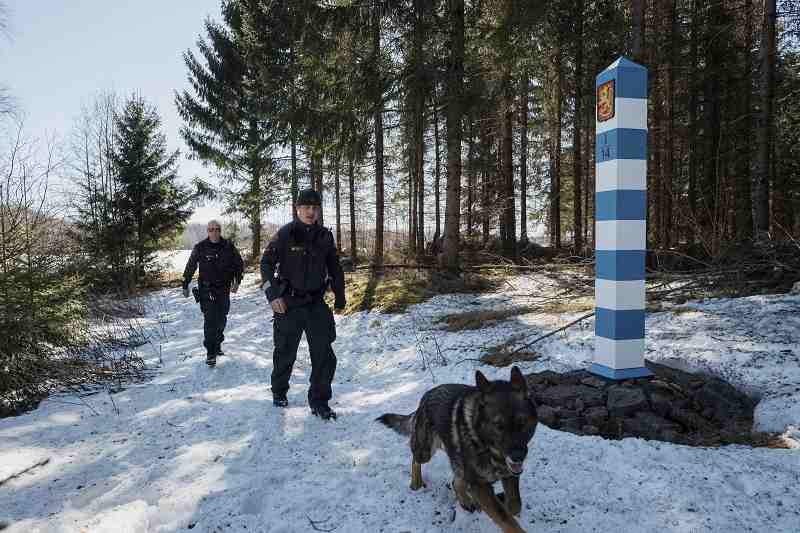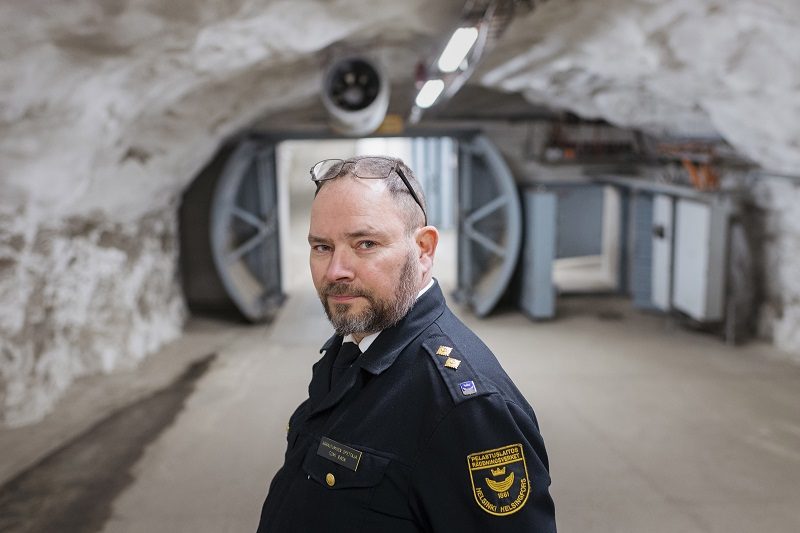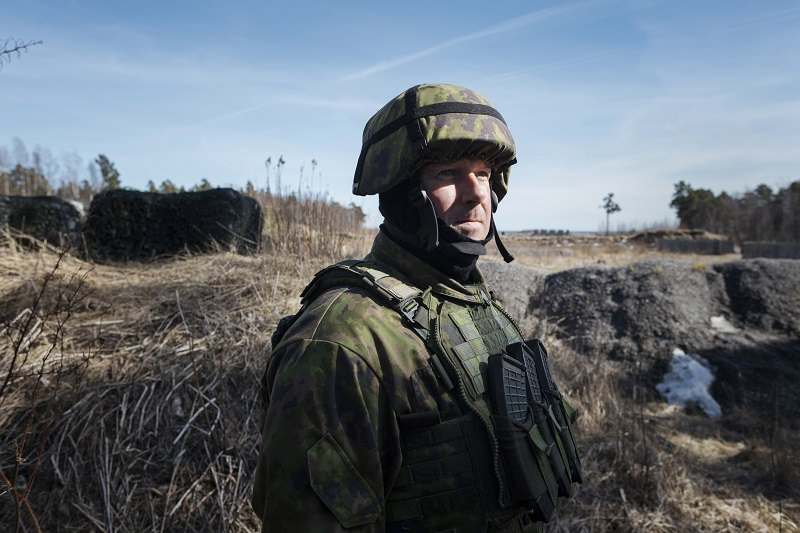
Border guards Marko Hytti, left, and Tuomas Rämä, with German shepherd Leif, patrol near Vaalimaa, Finland.
16:24 JST, May 2, 2022
NIIRALA, Finland – Two Finnish border guards glide through a narrow cut in a tall pine forest, their skis tracking a line along a still-frozen frontier.
Today the line marks the quiet but closely watched boundary between Russia and Finland. It may soon mark the border between Russia and the most powerful military alliance in the world.
Among the justifications for his unprovoked attack on Ukraine, Russian President Vladimir Putin cited the possibility of NATO expansion. Now the brutal war looks poised to bring NATO right to his door.
Any day now, Finland and Sweden – European Union countries that remain militarily nonaligned – are expected to apply to join the 30-member alliance. NATO and U.S. officials have said they would be welcomed.
This historic shift is an early sign of how Russia’s invasion of Ukraine is upending Europe’s post-Cold War security architecture and remaking world maps in ways that may be felt for decades.
Finland’s accession would double NATO’s land border with Russia. The two new members would bring the full force of the alliance to the far north and bolster a beefed-up presence around the Baltic Sea.
NATO, the United States and the E.U. are now planning for the long-term isolation of Russia, marking the return of Cold War-style containment after years of coexistence and cooperation.
“This is one of those moments in European history,” said Alexander Stubb, former prime minister of Finland. “What we are looking at is the semi-permanent division of Europe into two.”
On one side, he said, you have an aggressive, authoritarian Russia and its co-belligerent, Belarus. On the other side, you have more than 30 democracies more or less united by a common foe.
“It will all be one military-strategic arena now, especially if you look from the Russian side,” said Anna Wieslander, director for Northern Europe at the Atlantic Council.
“Putin miscalculated,” she said. “This is not what he foresaw.”
In some ways, this sea change in European security feels least surprising in Finland, the country whose anger and alarm at Putin’s actions precipitated the shift.
In the eight decades since Finnish soldiers on skis helped beat back Soviet invaders, the country joined the E.U. in 1995 and became a close NATO partner, while still trying to engage and understand Russia. But it has never taken its eyes off the border.

Border guard Tomi Timonen patrols near Niirala, Finland.
Tomi Timonen, deputy chief of the border guard station at Niirala, said those who live and work in the area are outraged, but not surprised, by Putin’s war. People here know Russia, he said. “Like all Finnish people, we are on our toes.”
Scenes from Ukraine stir painful memories for Finland.
In the 1939-1940 Winter War, the country fought off the Soviets but suffered mightily, losing people and territory. Ever since, said Henri Vanhanen, a foreign policy expert and adviser to the center-right National Coalition Party, the country has been intensely focused on defense. “It comes from our collective memory,” he said.

The Torkkelinmäki civil defense shelter is part of a network of shelters in Helsinki.
The capital, Helsinki, started building civil defense shelters in the 1940s. One 1960s-era facility designed to protect as many as 9,000 people from shelling and chemical attacks serves, for now, as a parking lot. The city also has shelters that are used as a sports center, a pool and an ice rink – but can be ready for emergency use in 72 hours.

Tomi Rask, of the Helsinki Rescue Department, in the Torkkelinmäki civil defense shelter.
Tomi Rask, a preparedness specialist with Helsinki’s Rescue Department, said footage of the devastating shelling in Ukraine, including people taking cover in makeshift shelters, has renewed interest in civil defense.
The focus on readiness extends to the military. Finland maintains a system of mandatory conscription for men and voluntary conscription for women. The country can muster a wartime force of 280,000 troops, as well as about 900,000 reservists.
“We never dismantled the military after the Cold War; we invested in it,” said Kai Sauer, Finland’s undersecretary of state for foreign and security policy.
“There is a very high willingness to defend the country,” he said. “It might sound old-fashioned, but it is a consequence of our history and geographic position.”
NATO officials and defense analysts described Finnish forces as robust and relatively well-funded. Just before the invasion of Ukraine, Finland finalized the purchase of 64 F-35 fighters from U.S. defense giant Lockheed Martin.

Ari Helenius, who served alongside NATO forces in Kosovo, oversees the exercise on Santahamina.
On the island of Santahamina, within Helsinki, the army trains troops in urban warfare, running gangly conscripts through live-fire drills. Watching them on a sunny April afternoon was Ari Helenius, a battalion commander who served alongside NATO forces in Kosovo.
Finnish soldiers have been working with NATO since the 1990s. Both Finland and Sweden contributed to missions in the Balkans, Afghanistan and Iraq. Both forces are highly interoperable with NATO forces.
The country stepped up cooperation with NATO after Russia annexed Crimea, but Finland remained officially militarily nonaligned. Finnish people felt safer outside the alliance.
Putin’s full-scale attack on Ukraine changed that virtually overnight. A majority of Finnish people now believe they would be safer within NATO.
“If Putin is able to slaughter his Slavic brothers, sisters and cousins in Ukraine, there’s nothing stopping him from doing that in Finland, as well,” said Stubb, the former prime minister.
Helenius said the situation in Ukraine is on the minds of young conscripts. “As professional soldiers, it is our job to tell them not to be worried,” he said.
Ukraine is also on the mind of the general public. Meri Leppänen, public information officer for the Guard Jaeger Regiment, which is based on the island, said the war has reminded the country “why we do what we do.”
Firing rifles and antitank weapons so close to the city used to yield noise complaints, she said. Since Feb. 24, nobody has called them to grouch about loud military training.
Jaakko Toropainen, a retired truck driver, said he used to be neutral on NATO membership, but the invasion changed his thinking.
His uncle was killed in the Winter War, and the country lost a lot, he said. Finland needs “all the help it can get” to stop that from happening again.
For now, he said, “I’m just hoping the other side doesn’t do anything stupid.”
At the Vaalimaa border crossing, a couple of hours outside Helsinki, the change in Finland’s relationship with Russia can already be seen.
Not long ago, the checkpoint was packed with transport trucks, travelers and cross-border shoppers headed to outlet malls – symbols of how Europe remained knitted to Russia despite the invasion of Georgia, the annexation of Crimea and everything else.
Thanks to pandemic and the war, a crossing built for thousands now sees a few hundred people a day, according to Capt. Jussi Pekkala, chief of the Vaalimaa border crossing point. Some Russians with E.U.-approved vaccines still visit, and the occasional transport truck lumbers by, but parking lots sit empty and the Zsar Outlet Village looks quiet. The guards greet E.U. citizens leaving Russia and Ukrainians fleeing war.
It seems unlikely that traffic will bounce back. Although NATO membership has no bearing on border policy, most people seem to accept that joining NATO would likely usher in a new era of division between the West and Russia reminiscent, in some ways, of the Cold War.
One lingering question is whether Finland and Sweden will pursue NATO membership in parallel. Sweden has thus far moved less quickly than Finland, but most analysts believe they will find a way to coordinate. The thinking, Wieslander said, is that if Russia is going to retaliate, “it is better if it happens once.”
Moscow has warned of unspecified “consequences” and said it will deploy nuclear weapons in the Baltic region if NATO grows. But European officials and analysts have for the most part played down those threats, noting that Russia already has nuclear weapons within range.
Janne Kuusela, defense policy director at the Finnish Ministry of Defense, said he did not expect Russian planners to make major changes to the country’s posture.
“It would not really be a huge change for Russian military calculus,” he said. Rather, the NATO move “would be a blow for their self-esteem, for their dignity, because they have been saying for a long time that they don’t want this to happen.”
Sauer, the undersecretary of state, said Finland is watching for hybrid or clandestine attacks. “All I can say is we are prepared,” he said.
He sees the standoff lasting. “Our foreign policy and security challenge is to have functional coexistence with Russia, and we have seriously tried to find ways to coexist and cooperate,” he said.
“Because of the Russian aggression, the situation has changed,” he continued. “It will take time to find a way out.”
"News Services" POPULAR ARTICLE
-

American Playwright Jeremy O. Harris Arrested in Japan on Alleged Drug Smuggling
-

Japan’s Nikkei Stock Average as JGB Yields, Yen Rise on Rate-Hike Bets
-

Japan’s Nikkei Stock Average Licks Wounds after Selloff Sparked by BOJ Hike Bets (UPDATE 1)
-

Japan’s Nikkei Stock Average Buoyed by Stable Yen; SoftBank’s Slide Caps Gains (UPDATE 1)
-

Japanese Bond Yields Zoom, Stocks Slide as Rate Hike Looms
JN ACCESS RANKING
-

Keidanren Chairman Yoshinobu Tsutsui Visits Kashiwazaki-Kariwa Nuclear Power Plant; Inspects New Emergency Safety System
-

Imports of Rare Earths from China Facing Delays, May Be Caused by Deterioration of Japan-China Relations
-

University of Tokyo Professor Discusses Japanese Economic Security in Interview Ahead of Forum
-

Tokyo Economic Security Forum to Hold Inaugural Meeting Amid Tense Global Environment
-

Japan Pulls out of Vietnam Nuclear Project, Complicating Hanoi’s Power Plans





















